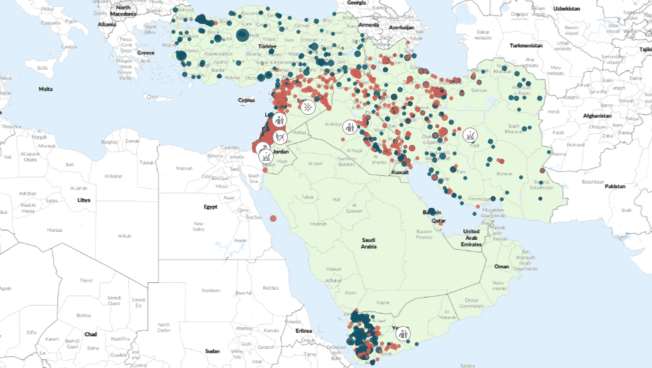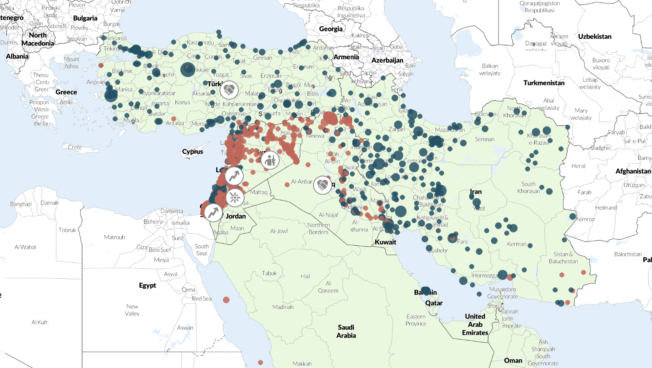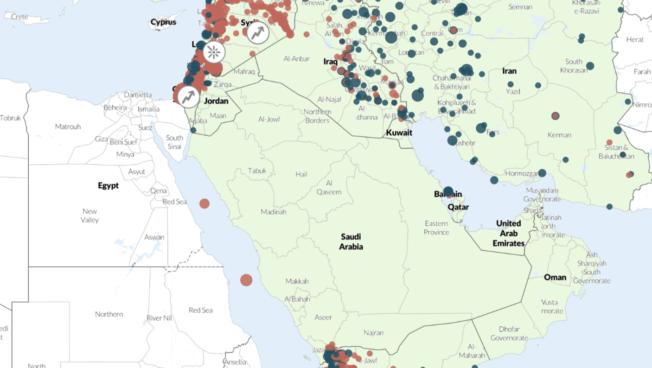Regional Overview
Middle East
February 2024
Posted: 8 March 2024
 Iraq and Syria: US carries out retaliatory airstrikes
Iraq and Syria: US carries out retaliatory airstrikes
Following the 29 January drone attack on a United States military outpost in Jordan that killed three American troops, the US conducted retaliatory strikes across Syria and Iraq. In 15 incidents on 2 and 3 February, the US targeted positions of Shiite militants in Iraq’s al-Anbar province and Islamic Revolutionary Guard Corps, Hezbollah, and pro-Iran militias’ positions in Syria’s Dayr al-Zawr. The attacks reportedly resulted in 57 militants killed. US airstrikes also hit the Iraqi capital of Baghdad on 7 February, killing the commander of Katibat Hizbullah’s missile and rocket units. The total number of attacks conducted by the US in Syria and Iraq against the members of the ‘axis of resistance’ increased by nearly 70% in February compared to the preceding month (for more, see the ACLED factsheet on US strikes in the Middle East). The US military avoided striking Iranian territory despite calls by Republican lawmakers, in an apparent effort by the Biden administration to reestablish deterrence without escalating the conflict even further.
Following the US airstrikes, attacks on US military positions and interests in Iraq and Syria decreased significantly. Compared to nearly 80 attacks recorded in January in Iraq and Syria, in February, ACLED records only 17 attacks — of which just five were claimed by the Islamic Resistance in Iraq, the umbrella group behind most attacks against the US in Syria and Iraq since last October. The decline followed an announcement by Kataib Hizbullah1Al Jazeera, ‘Kataib Hezbollah announces halt of attacks on US forces,’ 31 January 2024 — the most prominent member of the Islamic Resistance in Iraq — that it would suspend attacks against US positions in an attempt to de-escalate the situation following the deadly event in Jordan.
 Gaza: Israeli forces continue to advance in the south
Gaza: Israeli forces continue to advance in the south
Intense fighting continued in the central and southern Gaza Strip in February. Early in the month, clashes intensified in the western areas of Khan Yunis city, notably in the al-Amal neighborhood, Khan Yunis Camp, and near Naser Hospital. While armed clashes decreased throughout the month, Israeli forces continued to advance in western Khan Yunis toward al-Mawasi on the coast. Fighting also broke out in the eastern areas of Khan Yunis, particularly in Abasan al-Kabira, al-Qarara, and Bani Suheyla. Meanwhile, the Israeli military intensified its airstrikes in the Rafah area — including along the border with Egypt — throughout the month. In the north, where the Israeli military claimed to have dismantled Hamas in early January,2Emanuel Fabian, ‘3 months into war, IDF says it’s dismantled Hamas ‘military framework’ in north Gaza,’ Times of Israel, 6 January 2024 ACLED records nearly 50 clashes across Gaza City in February between Israeli forces and Hamas, Palestinian Islamic Jihad, and other Palestinian militant factions.
On the diplomatic front, efforts to reach a ceasefire deal between Israel and Hamas continued to falter. Fearing regional escalation, international meditators — spearheaded by the US, Qatar, and Egypt — increasingly pushed both sides for a truce before the start of the holy Muslim month of Ramadan in March, with major talks taking place in Cairo through early March.3Alex Marquardt and MJ Lee, ‘Talks for Gaza ceasefire at a standstill, no deal likely by Ramadan,’ CNN, 7 March 2024
 Iraq: Violence escalates between the Sadrist Movement and the Shiite Coordination Framework
Iraq: Violence escalates between the Sadrist Movement and the Shiite Coordination Framework
Violence between rival Shiite groups continued in February. This violence was driven by competition over the formation of provincial councils and the selection of new governors after the Shiite Coordination Framework (CF) made gains in the December provincial elections that were boycotted by the Sadrist Movement. The CF announced its intent to replace all provincial governors,4Yassin Taha, ‘Shiite Framework’s Internal Struggle with Governance over Governors,’ Rudaw, 18 February 2024 despite previous warnings from Muqtada al-Sadr against replacing Sadr-aligned Maysan and Najaf governors.5Staff, ‘Al-Sadr warns the parties and militias of the Coordination Framework against seizing Najaf and Maysan,’ Al-Rafidain TV, 23 December 2023 The CF’s selection of a new governor in Maysan on 8 February coincided with a series of assassination attempts targeting members of Asaib Ahl al-Haq, Nuri al-Maliki’s State of Law Coalition, the Sadrist Movement, and employees of the provincial council in Amara city between 4 and 9 February. Similarly, in Babil province, the assassination of a Sadrist activist triggered a shelling attack targeting Asaib Ahl al-Haq headquarters in Hilla city in late February. The recent intra-Shiite electoral violence demonstrates the latent tensions between Iraq’s Shiite blocs and their continued willingness to escalate violence in pursuit of political objectives.
 Lebanon: Israeli attacks intensify in lethality and expand in geographic scope
Lebanon: Israeli attacks intensify in lethality and expand in geographic scope
Hezbollah and Israeli forces continued their daily exchange of fire over the month of February, with increased lethality among both Hezbollah militants and Lebanese civilians. On 14 February, Israeli forces carried out their deadliest single attack in Lebanon since the start of ACLED data coverage in 2016 — killing three Hezbollah militants and eight civilians in an airstrike in Nabatiye town. Israel also expanded its targeting of Hezbollah militants and assets in Lebanon to new areas far from the border. In a first since the 2006 Lebanon war,6Beatrice Farhat, ‘Israel strikes deeper, hits Lebanon’s Baalbek in first since 2006 war,’ Al Monitor, 26 February 2024 on 25 February Israel carried out an airstrike in the Beqaa valley, about 100 kilometers from the border, that killed two Hezbollah members in response to Hezbollah shooting down an Israeli reconnaissance drone. Israel’s defense minister warned that Israel would step up its military operations against Hezbollah even if a ceasefire with Hamas is reached unless the Lebanese armed group pushes back from the border.7Melanie Lidman and Abbey Sewell, ‘Israel vows to target Lebanon’s Hezbollah even if cease-fire reached with Hamas in Gaza,’ Associated Press, 25 February 2024
 Syria: Regime intensifies suicide drone attacks in the rebel-held north
Syria: Regime intensifies suicide drone attacks in the rebel-held north
In Syria, regime and pro-Iran militias increased their use of suicide drones in opposition-held areas in Idleb, Hama, Aleppo, and Lattakia provinces. In February, ACLED records a total of 17 drone strikes targeting opposition and Islamist factions as well as civilians, compared to one strike in January. On 12 February, regime forces conducted a suicide drone attack on a gathering of Ansar al-Islam members near Upper Shaykh Sindyan in Idleb, killing four. In another attack, on 18 February, regime forces conducted suicide drone attacks targeting two Hayat Tahrir al-Sham (HTS) vehicles on Afes frontline in Idleb, killing three HTS members.
Meanwhile, daily protests demanding the overthrow of the Syrian regime continued across al-Suwayda province. Economic hardship and demands for greater freedom and political change sparked the protest movement in al-Suwayda, which began in mid-August 2023 following the government’s decision to cut back on fuel subsidies.8Staff, ‘One person killed at anti-government protest in Syria’s Sweida province,’ 28 February 2024 Although most of the protests were generally peaceful, a protester was killed on 28 February when regime security guards opened fire to disperse a protest taking place in front of the regime’s reconciliation center in the city of al-Suwayda.
 Yemen: Houthi attacks in the Red Sea and the Gulf of Aden sink their first ship
Yemen: Houthi attacks in the Red Sea and the Gulf of Aden sink their first ship
February started with a lull in Houthi maritime attacks, including a complete halt from 7 to 11 February. This coincided with a US cyberattack that targeted the Behshad Iranian spy ship in the Gulf of Aden, aimed at hindering the ship’s ability to collect and share intelligence with Houthi forces.9Courtney Kube and Carol E. Lee, ‘U.S. conducted cyberattack on suspected Iranian spy ship,’ NBC News, 15 February 2024 Attesting to the Houthis’ lack of intelligence in the earlier part of the month — and to the indiscriminate nature of their attacks — Houthi missiles targeted a bulk carrier that was transporting corn from Brazil to Iran on 12 February.
Houthi attacks resumed with increased intensity in the second half of the month, coinciding with the Behshad’s return to the Gulf of Aden after staying in Djibouti for several days.10Alex Longley, ‘Iranian Ship Back in Gulf of Aden After Reported US Cyberattack,’ Bloomberg, 22 February 2024 Houthi forces conducted 18 maritime attacks between 15 and 29 February, compared to 24 during the whole of January. On 18 February, a Houthi missile flooded the engine room of the Rubymar cargo ship in the Strait of Bab al-Mandab, forcing the crew to abandon ship. Although anchored, the ship drifted north in the Red Sea and ultimately sank on 2 March after leaving a 29 km oil slick from leaking fuel.11Richard Meade, ‘Sunken Rubymar’s only UK link was its disputed insurance cover,’ Lloyd’s List, 5 March 2024 The ship, which contains 21,000 tonnes of ammonium phosphate sulfate, now poses an environmental risk as well as a navigational hazard. The anchor dragging of the ship is also possibly responsible for cutting three undersea cables, which has affected 25% of the data traffic going through the Red Sea.12Jon Gambrell, ‘3 Red Sea data cables cut as Houthis launch more attacks in the vital waterway,’ Associated Press, 5 March 2024 In retaliation to Houthi maritime attacks, US-led strikes targeting Houthi drones and missiles and military positions inside Yemen increased by 75% in February compared to January.
For more, see the Red Sea attacks interactive map as part of the Yemen Conflict Observatory.
See More
See the Codebook and the User Guide for an overview of ACLED’s core methodology. For additional documentation, check the Resource Library. Region-specific methodology briefs can be accessed below.
Links:







